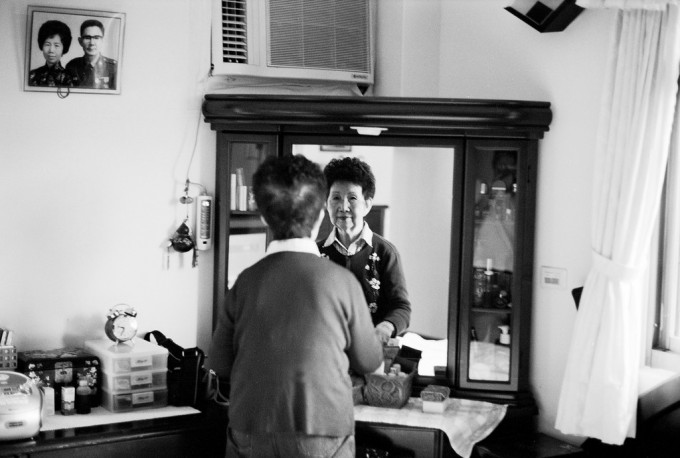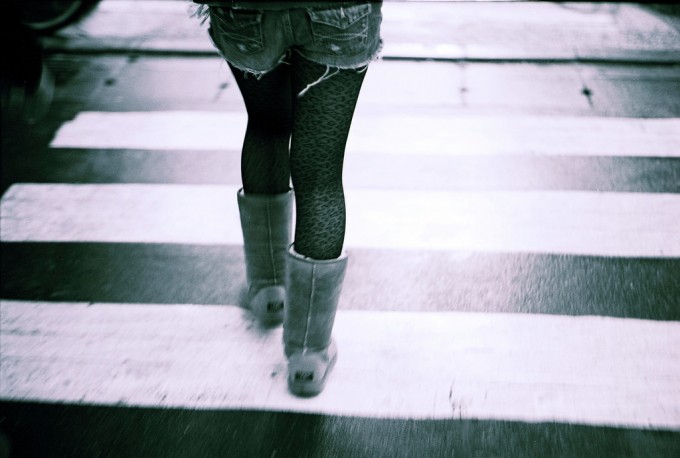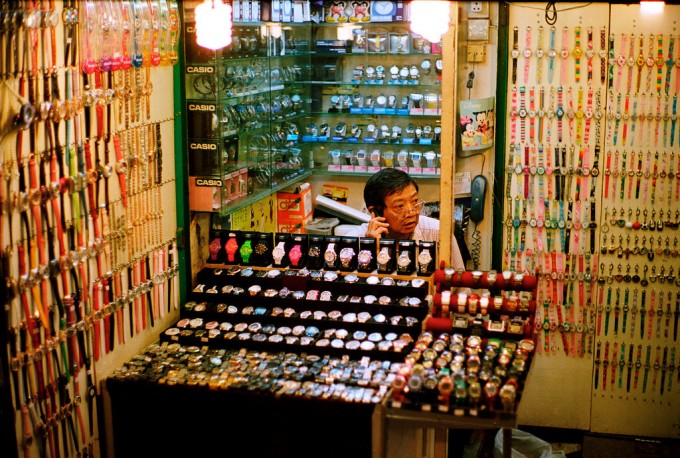A Trip To Hong Kong With The Leica M3
By Allen Liu
First, before I tell you about my recent trip to Taiwan and Hong Kong, I want to thank Steve for giving me the opportunity to share my experiences and photos. For the past 12 months, aside from when I was on vacation, I visited Steve’s site pretty much every day and sometimes two or three times a day. Even my fiancée, who has absolutely no interest in photography, knows who Steve Huff is. Through Steve’s site, I learned about rangefinders, I discovered Leica, and ultimately, film cameras.
Twelve months ago, I had never shot a photo with a rangefinder; now I am a proud owner of the Leica M8, M6, and my favorite of them all, a M3. Today, the Leica M3 goes literally everywhere I go. In almost every picture of me since the beginning of the year, you will see me wearing a messenger bag or sitting next to a messenger bag which has a Leica in it. Leica, especially the M3, has forced me to study photos, learn about the importance of light, and be able to determine the optimal aperture/shutter speed configuration to get exactly the image that I want.
The following statement is neither a joke nor exaggeration: I have more film in my refrigerator than food. The section normally reserved for fresh fruit is now completely filled with rolls upon rolls of 35mm film, black and white and color alike.
 Earlier this month, my lovely fiancée and I took a trip to Taiwan and Hong Kong. The purpose of the trip was twofold and particularly special. Not only were we going to visit her family in Hong Kong, but I would also introduce her, for the first time, to my family in Taiwan. It was an incredible two weeks filled with unbelievable people and unbelievable food. It was only fitting that I wanted to take unbelievable pictures.
Max Marinucci has written an excellent article about taking a trip with his Leica M3 here at Steve’s site (you can read that article HERE), which I must have read no less than 10 times. Being inspired, I decided to take the Leica M3 with me and left all my other electronics (cameras, laptops, phones, etc.) behind. However, at the very last minute (right before taking off to the airport), I decided to take the M8 with me just in case my film was confiscated by the TSA or accidentally exposed by the x-ray machines. At the end of my trip, I came home with around 250 photos. Less than 20 of them were shot with the M8. Like Max had mentioned, airport security was a breeze. I simply put all my film in a large clear plastic bag and asked that it be inspected by hand. Three minutes later, everything was good to go. All pictures here are shot with Kodak BW400CN, Kodak Portra 160NC, and Kodak Portra 160VC.
If you have never been to Hong Kong, I highly recommend that you experience it. Note I use the word experience — Hong Kong is a city unlike any other, at least of the ones I have visited.
Hong Kong is for lovers, Hong Kong is for photographers, Hong Kong is for food-seekers. Hong Kong is for anyone with an open mind and a passion for discovering the idiosyncrasies of the world around them. Because of its relatively small geographical size and the unique history stemming from 99 years of British occupation, Hong Kong is a place where you can find old-school Chinese traditional markets sandwiched between western-influenced ultra-modern office buildings and glamorous luxury brand boutiques. You will see elderly people carrying today’s fresh local produce on their shoulders walking alongside businessmen with an expensive briefcase and Starbucks coffee in hand. Nevertheless, the ever-present juxtapositions somehow manage to mesh together so harmoniously that nothing seems out of place.
 In the end, after looking at the photos, I am very happy about my decision to shoot predominantly with the M3. What am I going to do with the M8 now, you ask? I guess I will probably only use it when I want to try out a new lens and want immediate results. Leica M3 and this trip have taught me more than I could have imagined, and as a beginner in photography, I smile every time when I think about it.
Once again, I want to thank Steve for this great site and for more pictures of this trip, you can find them at http://badallen.smugmug.com/Travel/Taiwan-HK/.
allen
[ad#Adsense Blog Sq Embed Image]












Very nice article, full of accurate comments and, above all, great photos, which is what matters most!
I have recently visited Hong Kong for the first time and I totally relate to the “experience” that you mention, this is a city with a soul, or hundred souls, and it’s a question of “living” it. Though I didn’t use a rangefinder but a micro 4/3 camera, you can set my post with multiple images about the trip here:
http://gonzalobroto.blogspot.com/2014/02/delayed-weekend-in-hong-kong.html
Hong Kong is a great place for street and architectural photography. Here are some of mine from a November 2010 trip. Shot with an M8 and a Canon G11.
http://www.flickr.com/photos/life_in_shadows/sets/72157625302258709/
Great shots! I love Hong Kong is a great place for street.
Dear Allen,
Thank you for your kind and humorous replies. What politicised your comments on HK’s history was the use of “occupied”, as if that were something unpleasant and forced upon. If you had used a word such as “governed” it would have been accurate without inferring oppressive control of a territory and its inhabitants. Hong Kong was a tiny fishing village when China ceded it to Britain. In fact, the general opinion at the time was that Britain had gotten by far the worst side of the deal!
Anyway, thank you for clearing up any mis-read perceptions. I agree HK is a fascinating city, and a wonderful playground for photographers.
Some nice photos.
Having lived in HK for 22 years, you have captured some of the moods.
I must however take exception to your description of Britain having “occupied” HK for 99 years. This is factually incorrect on both main points.
Hong Kong island was ceded by China to Britain in perpetuity in 1842 under the Treaty of Nanking. Kowloon was ceded in perpetuity a few years later, and the New Territories were leased for 99 years in 1898.
I have other opinions on Hong Kong, but have simply stated the facts. Please do not bring unobjective politics to an otherwise enjoyable hobby site.
Hi Fred! First of all, I want to thank you for your good words on my pictures and the correction of the “99 years of British occupation” statement.
However, perhaps because of my poor understanding of English words and/or the language itself, I don’t get why people think “99 years of British occupation” is a statement about politics rather than about the historical event. The statement itself is just like “Dwight Eisenhower is the 34th President of the United States”; it is a statement of history, not politics. I was merely stating my understanding of a historical event and use that to accentuate, in my opinion, the perfect blend of the East and the West.
I welcome the correction on my inefficient knowledge of the number of years of the British occupation as a historical event; but please do not mistake me as someone who tries to argue about politics.
Further more, if my understanding is correct (which I can be very wrong and that’s why I am not a history professor), most of the territories that make up what is “Hong Kong” now were under the govern of England for at least 99 years. So 99 years is just the lowest common denominator! But the next time, if I am going to write a similar article, I will make sure to spell out the exact year for each of the territories and specify them as historical statements with absolutely no political agenda behind them.
All jokes aside, I do appreciate your comment and I definitely do not want to pollute this blog with any political topic and I apologize if I unknowingly appeared so.
Whew, I just checked. Eisenhower is indeed the 34th, I am glad at least I have that part correct.
Thanks for the great article and inspiring pictures. I just returned from a trip to Thailand with my M2 (I got it coz I usually shoot a 35mm lens and didn´t want the extra weight and complication of the goggles). For a lightmeter I use the “Pocket Light Meter” for the iPhone. Old technology meets new. I am amazed at the quality of images I got on Tmax 400 film.
I have to add… and I mean this VERY seriously, the BEST images are on the bigger Flickr set. Some of those shots should be in galleries.
Great story spiced with amazing photos. I haven’t enjoyed a photo story like this for a long long time 🙂
Allen – Really enjoyed this series – it inspired me to get the film camera out and get back to basics
Thanks for posting – best wishes John
Ahh the joys of photographic simplicity and a great city to shoot in…. Great work Allen! Its great to see more travelers leave all of their belongings home and focus on photography!
Allen, what a great treat it is to read your report; you are obviously delighted with your trip, and thanks for sharing your excellent work. Yes, an M3 is a magical device. Good luck.
Excellent article and photos, Allen. The M3 is a special camera that I am sure will bring you many years of joy and memorable images. Enjoy!
PS.. that pre-asph Summilux is one amazing lens, along with the Summicron DR. If you had to have two 50mm, you’d have that plenty covered with those.
All the best,
Max
“99 years of British occupation” – excellent, we start politics even here.
Honestly, I dont think anyone cares. Here´s the full story. http://en.wikipedia.org/wiki/Hong_Kong So what?
Martin, please see my reply to Fred 9. Thank you!
Apparently I am not allow to say “thank you” too many times, the blog comment police is telling me I am repeating my comments too many times! 🙂
So to everyone whom has been so very kind to me and my pictures, I really appreciate it! It means a lot to me!
As a longish term resident of HK (one of the briefcase + *bucks brigade) who has recently switched from DSLR to an M9 (but also owns a 1959 M3) I found the shots very refreshing and I enjoyed the narrative too. It is good to see something I live every day through someone else’s eyes. The first and last are my favourites. Some excellent vision here from Allen and I encourage as many photographers as possible to visit this most photogenic of cities.
Do you do your own developing or send yur negatives out? I have been thinking about pulling out my film cameras again but don’t want to deal with developing any more.
Soren, normally I will develop my own black&white and send the color out. However, since I was travelling, I purposely picked BW400CN (a C-41 film) as my only black&white film on this trip so I could have the local labs developing them for me while I was there! In my opinion BW400CN is a great choice for travelling or if you can’t develop b&w films yourself.
Soren, a hybrid workflow seems the way to go today. I shoot film (C41 exclusively) also Ilford XP2 which is black and white film that can be processed in color chemicals. I have the film developed at a local lab and the scan myself on a Plustek 7600 scanner.
Holy cow. Stunning colorful seductive images. And from a relative newcomer to photography? Wow. But maybe the best parts of this are your personal reflections which are presented without pretense or affectation. Here’s hoping you’re a regular contributor here on Steve’s incredible website.
Fantastic post, Allen. Love all the pics, but especially the last two.
I was going to say 50mm myself. Awesome pictures and article.
Sweet shots. Magic of film.
Amazing photos Allen.
Your photos stirs up memories of my last trip to Hong Kong. Thanks for sharing.
My favourite photo is the man with the umbrella walking down the stairs. The lighting was perfect.
Also your first photo of the elderly lady in her room has that timeless quality. It could have been taken 50 years ago or yesterday.
Beautiful photos!
Wasn’t HK a wonderful place?
I really really like the umbrella photo as well, It is actually my wallpaper!
The elderly lady is my grandma, she is the kindest woman i have ever met.
Thanks for the shots and write up Allen! Your passion for photography really came through. Curious, how did you scan your negatives in?
Seb
I got a Plustek 7300 when I first started shooting with films and the M6; I have been using it ever since. I am not sure if I am always happy with the result, therefore, I am still trying to hunt down a decent scanner like Nikon Coolscan.
I like the black and white frame of the young couple hugging whilst a man walk past them on the left.
It appears she’s in distress and he’s conforting her – very genuine emotion and body language, so sweet.
I love your write up, smooth reading and articulate.
Thanks you!
If I had to guess I would say 35mm 🙂
Hi Stephen,
the M3 is “made for” 2 focal lengths: 50mm and 90mm.
Hence my guess is Allen used a 50mm lens.
To use 35mm on the M3 you need a lens with “goggles” to reduce the viewfinders magnification….. this makes the camera somewhat bulky…
cheers,
c.
Thanks Chris, that makes sense.
You are correct, Sir. I brought a 50mm Summilux and a 21mm Color-Skopar with me, but I think all of the pictures here were taken with the 50mm Summilux.
A very nice read and great photos! Thanks! I myself is a recent and very happy M3 shooter 🙂 May I ask you how you measure light? Do you use an external light meter or go by experience?
Anders
I brought an external light meter (Sekonic L-398A) with me; but more often than not, I just sort of “guesstimated” it. Fortunately, the films I brought with me (BW400CN, 160VC/NC) all have pretty forgiving exposure latitude.
These are stunning pictures and I love your passion for the M way of shooting. You will find yourself in good company here! May I ask which focal length lens you used?
I think all of the pictures here were shot with the 50mm Pre-Asph Summilux.
Very nice shots Allen – I enjoyed your article and photos ! – Kind regards
Roy